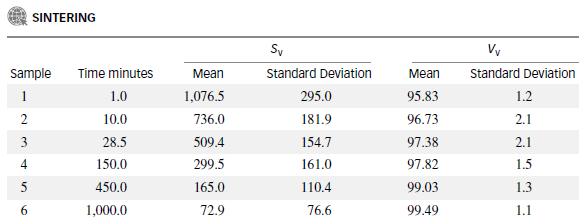Sintering, one of the most important techniques of materials science, is used to convert a powdered material
Question:
Sintering, one of the most important techniques of materials science, is used to convert a powdered material into a porous solid body. The following two measures characterize the final product:
 When Vv = 100%, the product is completely solid—i.e., it contains no pores. Both Vv and Sv are estimated by a microscopic examination of polished cross sections of sintered material. Generally, the longer a powdered material is sintered, the more solid will be the product. Thus, we would expect Sv to decrease and Vv to increase as the sintering time is increased. The table at the bottom of the page gives the mean and standard deviation of the values of Sv (in squared centimeters per cubic centimeter) and Vv (percentage) for 100 specimens of sintered nickel for six different sintering times.*
When Vv = 100%, the product is completely solid—i.e., it contains no pores. Both Vv and Sv are estimated by a microscopic examination of polished cross sections of sintered material. Generally, the longer a powdered material is sintered, the more solid will be the product. Thus, we would expect Sv to decrease and Vv to increase as the sintering time is increased. The table at the bottom of the page gives the mean and standard deviation of the values of Sv (in squared centimeters per cubic centimeter) and Vv (percentage) for 100 specimens of sintered nickel for six different sintering times.*
a. Plot the sample means of the Sv measurements versus sintering time. Hypothesize a linear model relating mean Sv to sintering time x.
b. Plot the sample means of the Vv measurements versus sintering time. Hypothesize a linear model relating mean Vv to sintering time x.
c. Fit a linear model relating E(Sv) to sintering time x. Show that the data may violate the assumptions of Section 11.2. What model modifications do you suggest?
d. Consider second-order model relating Vv to sintering time x. Fit the model E(Vv) = βo + β1x + β2x2 to the data and conduct a complete regression analysis. Ultimately, you want to predict the value of Vv at sintering time 150 minutes.
e. The unstable values of the standard deviations for Sv shown in the table indicate a strong possibility that the standard regression assumption of equal variance is violated for the model of part c. We can satisfy this assumption by transforming the response to a new response that has a constant variance. Consider the natural log transform* Sv* = ln(Sv). Fit the model E (Sv*) = βo + β1x to the data and give the leastsquares
prediction equation.
f. Is the model in part e adequate for predicting ln(Sv)? Test using α = .05.
g. Refer to the model, part e. The predicted value of Sv is the antilog,

To obtain a prediction interval for Sv, you need to take the anti logs of the endpoints of the prediction interval for Sv*.† Find a 95% prediction interval for Sv when the sintering time is 150 minutes.

Step by Step Answer:

Statistics For Engineering And The Sciences
ISBN: 9781498728850
6th Edition
Authors: William M. Mendenhall, Terry L. Sincich




